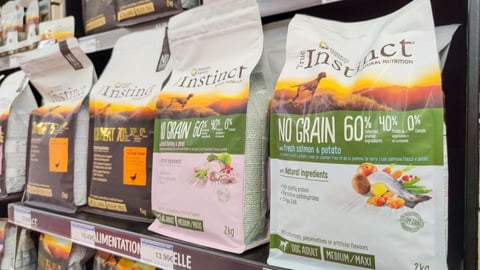As Climate Change Drives Disruptions, Digitalization Is Key to Building Supply Chain Resilience
This summer was the hottest on record, with accelerations in climate change driving extreme heat waves, wildfires, and hurricanes on a global scale. The rising temperatures and nonlinear weather patterns have had a detrimental effect on supply chains.
More than two-thirds of U.S. businesses were at heightened risk of operational downtime due to potential power grid blackouts. HVAC companies were inundated with service requests from commercial clients needing repairs, driving intense demand for spare inventory parts and replacement air conditioning units. Aldi stores in Germany were forced to stock locally grown asparagus and strawberries after heat-related droughts in Spain limited wide scale suppliers.
These challenges are byproducts of a new normal for grocers, retailers, and healthcare organizations amid accelerating climate change, where severe weather events ripple into operational disruptions that increase risk across the end-to-end supply chain. In addition to spoiling perishable food products, causing foodborne illnesses, and damaging temperature-sensitive medications, weather events also hinder staff-wide efficiency. According to an International Labor Organization (ILO) report, heatwaves are projected to reduce working hours worldwide by over 2% by 2030 — equivalent to losing 80 million full-time jobs and $2.4 billion globally.
In turn, integrating IoT, artificial intelligence (AI) and machine learning (ML) technologies to drive supply chain process optimization is critical to mitigating risk. Now more than ever, supply chain digitalization isn’t just a nice-to-have in our current business environment. It’s a crucial component to meeting food safety standards, delivering a high-quality customer experience, and positioning employees to be productive.
AI-powered prescriptive analytics in conjunction with IoT sensing and monitoring solutions fuse greater levels of visibility and traceability across each touchpoint of the supply chain. From remote temperature monitoring to real-time location sensing, the capabilities of IoT-enabled supply chain technologies are imperative to navigating the unexpected twists and turns of climate-related disruptions.
The Role of Visibility: Automated Remote Temperature Monitoring
For grocers and food retailers, prolonged power outages affecting refrigerators and freezers underscore the need for automated remote temperature monitoring. After power is restored, store operators must be able to confirm whether products inside the affected assets stayed within optimal temperature thresholds during the downtime — which in turn determines their state.
Chicken, for example, must be stored at 41 degrees Fahrenheit per HACCP food safety standards to be safe to eat. If a power outage only lasted 10 minutes and the refrigerator door remained shut, there’s still a good chance that the temperature setting did not exceed 41 degrees. However, there are no guarantees — and for customer safety and compliance purposes, organizations need verifiable proof that the temperature threshold was maintained despite the incident.
The integrated adoption of IoT-enabled food chain technologies allows store operators to act on data-driven facts instead of guessing with anecdotal reasoning. An IoT condition monitoring solution placed inside the affected refrigerator collecting real-time environmental setting data can confirm the 41-degree threshold was maintained. Based on the forecasted temperature degradation, the solution shares a warning of the impacted inventory by sending a data feedback loop to its centralized prescriptive analytics platform that logs the temperature reading and generates prescriptive directives.
A store operator then follows the directive to determine which packages of chicken should be discarded. Compounded at scale across hundreds of stores, automating this process also helps mitigate spoilage risk and reduce unnecessary waste to create a balancing act between the traditionally siloed functions of food safety and loss prevention.
The Role of Traceability: Scalable Real-time Location Sensing
In a similar realm, most common medications and vaccines used by retail pharmacies and hospitals require stringent storage environments to maintain efficacy and safety. While shipping products in extreme heat over the summer months, it’s not uncommon for temperature thresholds to exceed their maximum limits inside warehouses, distribution trucks, and back-of-house inventory settings.
In May 2023, for example, Family Dollar was forced to recall several varieties of Advil due to being stored in improper temperature settings exceeding 100 degrees Fahrenheit caused them to lose their strength. Family Dollar determined that the recalled medication was stored and shipped to stores from June 2022 to March 2023. It followed two separate recalls from the national retail chain in 2022 that affected more than 400 products. However, it’s important to remember that Family Dollar isn’t alone — similar recalls from brands of all sizes and sectors arise across the U.S. on a regular basis. In reality, excursions are bound to happen with millions of healthcare CPG products moving through the supply chain every day.
This challenge signifies the critical role of supply chain traceability from real-time location sensing services used alongside automated temperature monitoring. After detecting a temperature or humidity excursion that requires a mass recall, organizations need to be able to seamlessly track and trace all products through the supply chain to 1) ensure the impacted medications do not reach consumers or 2) identify impacted medications that were already sold. By logging real-time location data alongside corresponding temperature data, store operators can pinpoint which shipments were exposed and take proactive steps to remove them from distribution or communicate to customers to discard them.
From extreme heat and droughts to wildfires and hurricanes, the detrimental impact of climate change is visible far and wide. While it’s critical that we all do our part to reduce global carbon emissions with sustainable business models, supply chain leaders also need to put preventative measures in place at a systemic level to better mitigate climate-related operational risk in the years to come.
The integrated adoption of supply chain digitalization through IoT, AI, and ML tools is key to an effective and efficient supply chain that is resilient to extreme weather.
—Guy Yehiav, President of SmartSense by Digi




